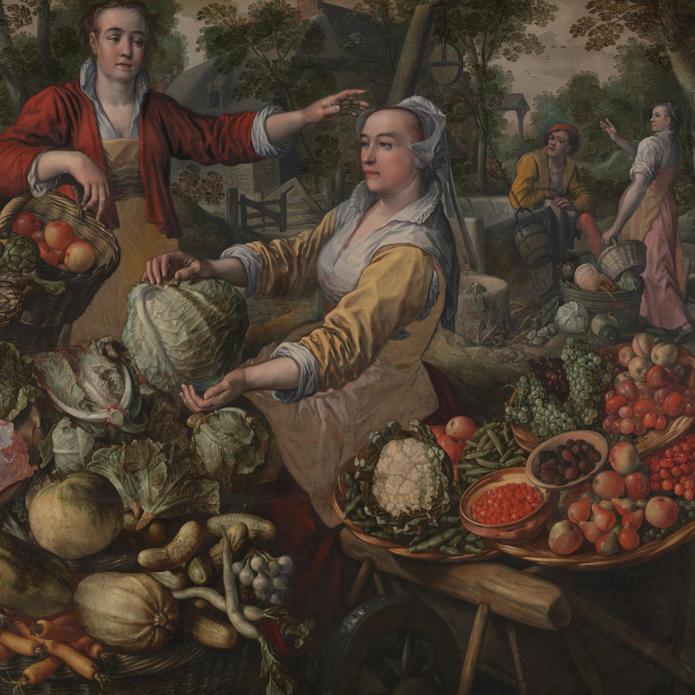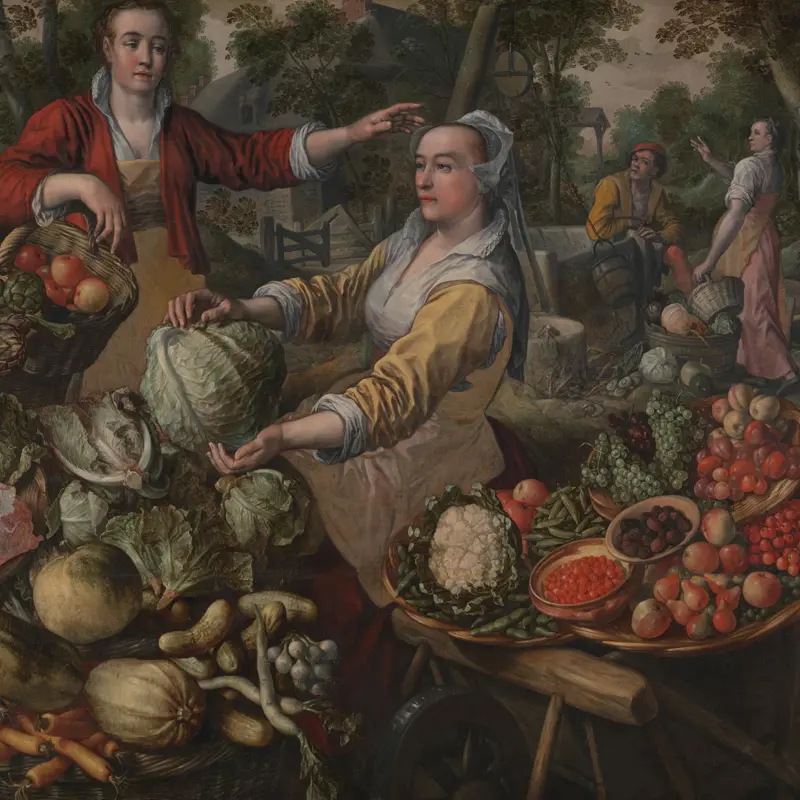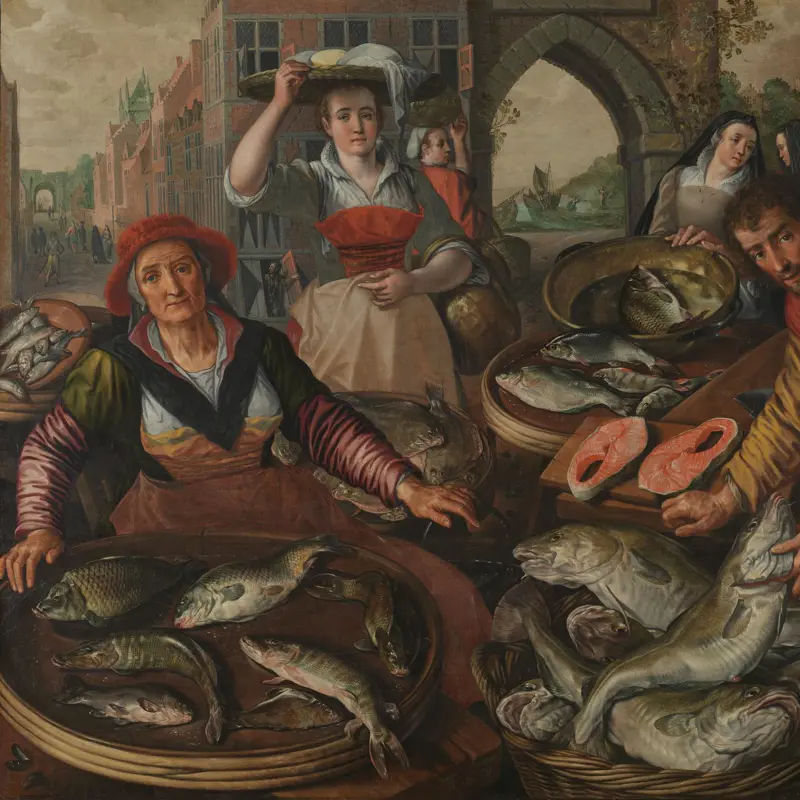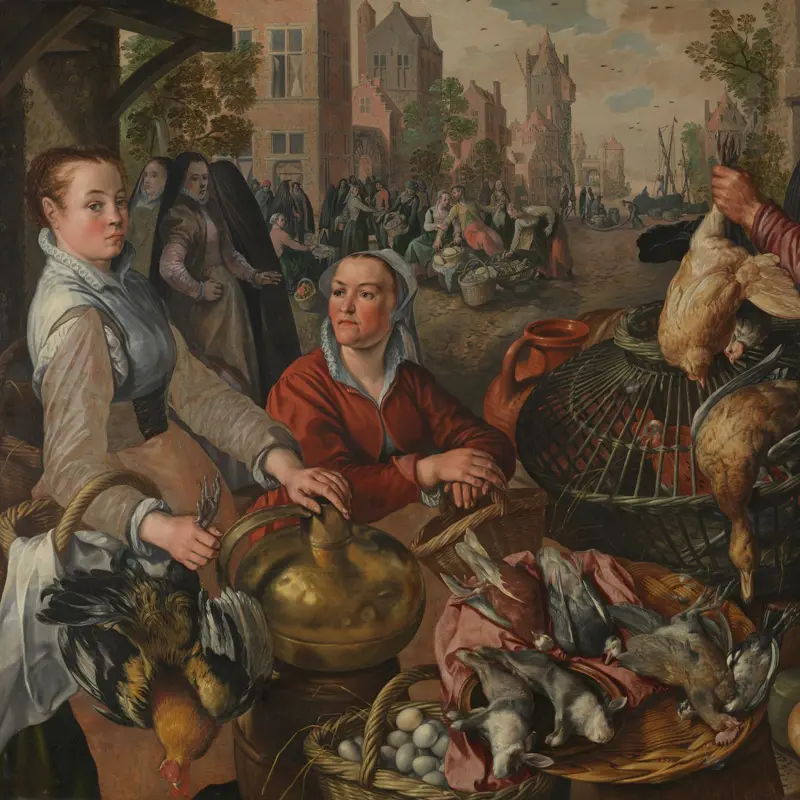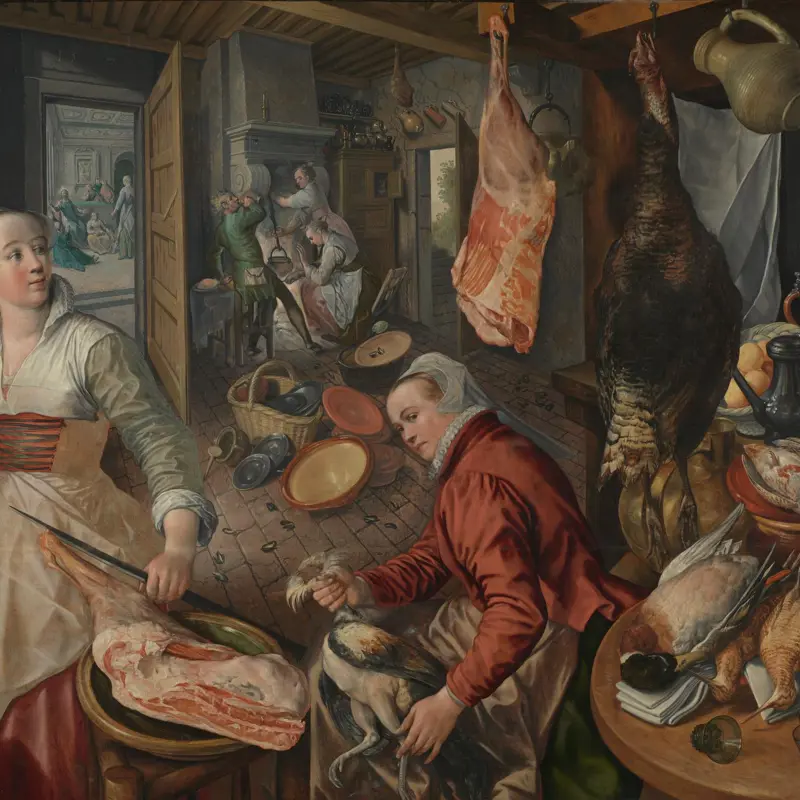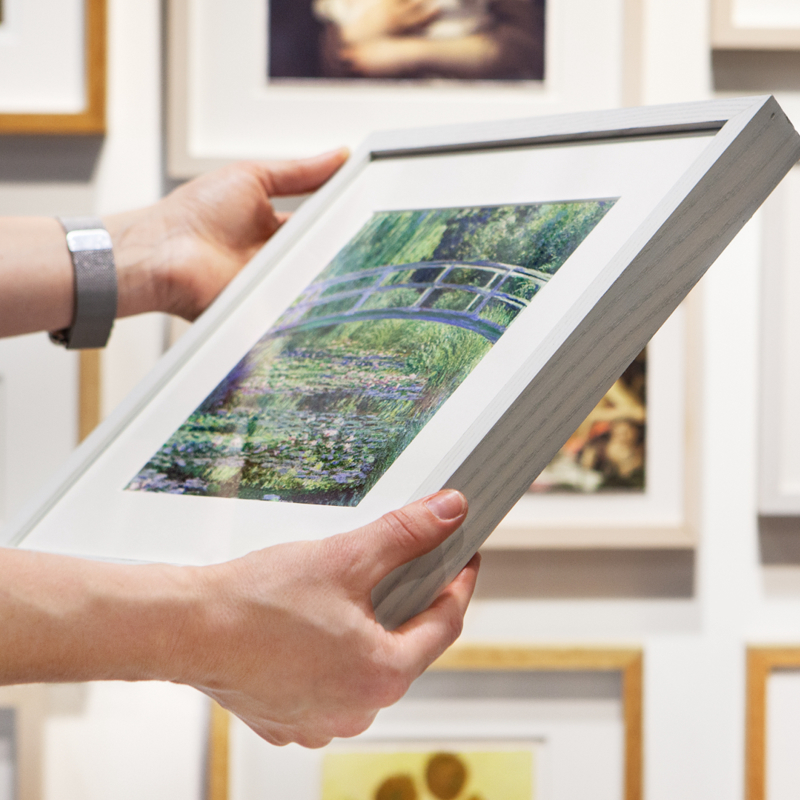Joachim Beuckelaer, 'The Four Elements: Water', 1569
About the work
Overview
A plethora of piscine produce is presented to us: fish of all kinds are piled in baskets, tumble over the edges of platters or slip from the stallholder’s grasp – there are even mussel shells scattered on the floor. The two vendors ignore their prospective clients and look directly at us, as if asking us to buy. This is one of four large pictures in the National Gallery’s collection in which the four elements – earth, air, fire and water – are represented as food.
Although it looks like a contemporary scene, something else is going on too. Through the arch in the middle you can see a ship with fishermen hauling in their nets. One man wades through the water towards a figure on the shore. This is the miraculous draught of fishes, when Christ, risen from the dead, appeared to his apostles and told them to cast their nets on the other side of the boat. They pulled in a multitude of fish.
Key facts
Details
- Full title
- The Four Elements: Water
- Artist
- Joachim Beuckelaer
- Artist dates
- Probably about 1535; died 1575
- Part of the series
- The Four Elements
- Date made
- 1569
- Medium and support
- Oil on canvas
- Dimensions
- 158.1 × 214.9 cm
- Inscription summary
- Signed; Dated
- Acquisition credit
- Bought, 2001
- Inventory number
- NG6586
- Location
- Room 15 Stairs
- Collection
- Main Collection
- Frame
- 17th-century Italian Frame
Provenance
By 1884, NG6585-NG6588, with a fifth also attributed to Beuckelaer, were in Room 12 of the gallery of the Palazzo Panciatichi (entrance via di Pinti 62), Florence. The palace and the paintings belonged to Ferdinando Panciatichi Ximenes d’Aragona (1813–1897), Marchese di Saturnia e d’Esche (Esche being in Bavaria). Ferdinando had made important additions to the ‘already considerable’ collections formed by his ancestors. The Four Elements could have come to him from his Panciatichi ancestors or from the Ximenes d’Aragona; alternatively, he could have inherited them from the Guicciardini, Valori or Pecori families. The Marchese died in 1897, leaving his property to his great-grandchildren. Their grandmother, the Marchese’s daughter Marianna Paolucci, had a life interest and decided to sell the collection – except portraits of members of the Panciatichi and Ximenes families and objects decorated with their coats of arms. The sale, directed by Galardelli and Mazzoni, took place on 3 April 1902 and the following days. The Beuckelaers, still in Room 12 (‘Salle L’), were sold as lot 165 on 11 April: ‘BEUCKELAER JOACHIM (1570) (Signé) LE MARCHE au gibier – le Marché aux légumes – le Marché aux poissons et la Cuisine. Quatre magnifiques compositions sur toile, pour décoration de salle à manger. Cadres dorés. M. 1.55 x 2.12.’ Air was reproduced in the sale catalogue. The next lot, 166, was obviously the fifth painting mentioned in 1884: ‘BEUCKELAER JOACHIM (1570) JEUNE BONNE au Marché. Cadre doré. Bois. M.1.55 x 1.95.’ The names of the purchasers have not been discovered; the fifth painting has not been traced.
In the Friedländer Archives at the Rijksbureau voor Kunsthistorische Documentatie, The Hague, are old photographs of three of the Four Elements. On the back of the photograph of Air, someone – probably not Friedländer himself – has written ‘Verz[ameling] Langevelt-Campens/Bruxelles/Rue Royale/161 [or 61]’. Modeste Langevelt (1871–1914) dealt in pictures and in 1912 was living at 202 rue Royale in Brussels. In 1899 he married, as his second wife, Elvire Marthe Campens (born 1871). She would appear to have been the ‘Langevelt-Campens’ whose name is written on the back of Friedländer’s photograph.
By 1942 NG6585-NG6588 were in the possession of Robert Goffinet (1886–1945) who owned two adjoining houses at 167–169 rue de la Loi, Brussels. His nephew Jean Goffinet remembered seeing them in that year at 167 rue de la Loi. This house had belonged to Robert Goffinet’s mother Jeanne Quairier, widow of General Théodule Goffinet (1851–1907) and daughter of Joseph Quairier, Avocat à la Cour de Cassation and Directeur de la Société Générale de Belgique. It seems likely that the pictures had belonged to Jeanne Goffinet-Quairier, who might have inherited them from her father. She died in 1930. At the Institut Royal du Patrimoine Artistique in Brussels are old photographs of the four paintings ‘possibly taken about 1930–40 by the photographer Becker of Brussels’: no one knows when or where the negatives were made. The four pictures, probably in the possession of the Goffinet family by 1930 and certainly owned by Robert Goffinet in 1942, passed to Robert’s brother Louis Goffinet (1892–1959), who lived at the château of Hyon, south of Mons. He left his property to his wife (Marie-Louise-Augusta Bouilliart de Saint-Symphorien); after her death in February 1979, their heirs sold the paintings and the château (bought from them on 14 November 1980 and demolished in 1983).
NG6585-NG6588 were eventually taken to a bank in Brussels, where they were under the care of two dealers, René Reding and F. De Scheemaecker. Offered for sale to the City of Antwerp, they were shown on 4 November 1981 to Carl Van de Velde. He was told that they had come from a castle near Mons; the owner’s name was not disclosed. Shortly afterwards, apparently in 1982, they were sold to Herman Van Roey, a collector, who was advised by the art historian Paul Verbraeken and who in 1986 lent them to the Museum voor Schone Kunsten in Ghent. They were the centrepiece of the exhibition Joachim Beuckelaer, Het markt- en keukenstuk in de Nederlanden 1550–1650, 12 December 1986 to 8 March 1987, and remained on public view at the museum until Mr Van Roey sent them to Christie’s, London, where they were sold on 13 December 2000 (lot 25) to the dealer Robert Noortman, Maastricht. They were bought for £3,323,821.88 from Robert Noortman in 2001, the purchase funded by the American Friends of the National Gallery, London.
Additional information
This painting is included in a list of works with incomplete provenance from 1933–1945; for more information see Whereabouts of paintings 1933–1945.
Text extracted from the ‘Provenance’ section of the catalogue entry in Lorne Campbell, ‘National Gallery Catalogues: The Sixteenth Century Netherlandish Paintings: With French Paintings before 1600’, London 2014; for further information, see the full catalogue entry.
Exhibition history
-
2023Masterpieces from the National GalleryShanghai Art Museum East17 January 2023 - 7 May 2023National Museum of Korea2 June 2023 - 9 October 2023Hong Kong Palace Museum22 November 2023 - 11 April 2024Chimei Museum2 May 2024 - 1 September 2024
Bibliography
-
2001National Gallery, The National Gallery Review: April 2000 - March 2001, London 2001
-
2014
L. Campbell, National Gallery Catalogues: The Sixteenth Century Netherlandish Paintings: With French Paintings before 1600, 2 vols, London 2014
-
2015K.L.M. Aluwé, B.M. Starkovich and J. Van Vaerenbergh, 'The Diet of the Portuguese Merchant Family Ximenez at the "Blauwhof" (Belgium): Between Tradition and Display in the 16th–17th Centuries', Journal of Archaeological Science: Reports, III, September 2015, pp. 581-90
-
2017M. Poulain, J. Van Vaerenbergh and W. De Clerq, 'A Portuguese Lifestyle in the Flemish Countryside: Ceramics of the Ximenez family (1595-c. 1700)', Post-Medieval Archaeology, LI/2, 27 November 2017, pp. 274-308
Frame
This seventeenth-century Italian poplar wood frame was made specifically for this painting, one of a group of four works by Beuckelaer (Water, Fire, Earth and Air) set in identical frames. The Baroque moulding, in profile, features a deep S-shaped curvature. The frame is mitred at the front and secured at the back with a half-lap joint and nails – a typical feature of Florentine framing. The only embellishments are the carved – or turned – pearls along the sight edge.
In the nineteenth century, the frames were overgilded with oil gilding. The sanded hollow at the back edge of each frame may have been added later, possibly to cover cracks in the wood.
In a 1902 sales catalogue for the paintings (Catalogue Borgo Pinti), the frames are referred to as ‘cadres dorés’ (gilded frames). An image of Beuckelaer’s Air is also reproduced in the catalogue, in its current frame.
About this record
If you know more about this work or have spotted an error, please contact us. Please note that exhibition histories are listed from 2009 onwards. Bibliographies may not be complete; more comprehensive information is available in the National Gallery Library.
Images
About the series: The Four Elements
Overview
Packed with fish, fruit, vegetables, birds and animals, these four big pictures are like giant stage sets, teeming with life. Although superficially market and kitchen scenes, the different types of food represent the four elements: vegetables for earth, fish for water, poultry for air and game for fire. In the backgrounds are biblical scenes.
Beuckelaer has created an impression of great abundance and variety, although the foods shown were readily available to ordinary Netherlanders for most of the sixteenth century. However, these pictures were painted at a time of political and religious repression and severe economic recession. They perhaps show a remembered golden age, when food was plentiful.
The group may well have been commissioned in Antwerp by a foreigner, probably the vastly wealthy and cultured Fernão Ximenes, Consul for the Portuguese Nation. By 1884 the paintings were in Florence, in the Palazzo Panciatichi-Ximenes d'Aragona.

